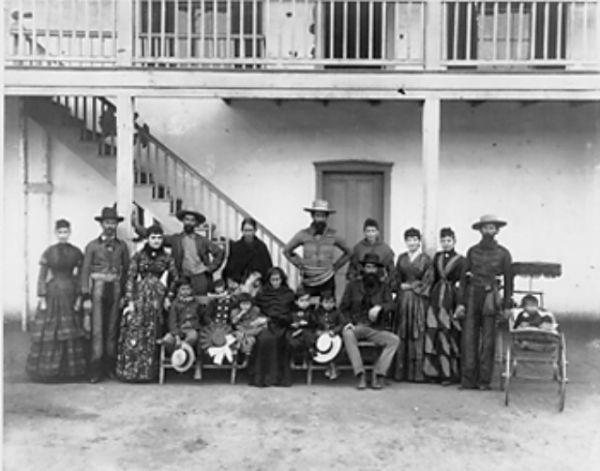Ian Mortimer, author of Time Traveler's Guide to Medieval England, takes us on a shopping trip in a 14th-century marketplace
The poet WH Auden once suggested that, in order to understand your
own country, you need to have lived in at least two others. But what
about your own time? By the same reckoning, you need to have experienced
at least two other centuries. This presents us with some difficulties.
But through historical research, coming to terms with another century is
not impossible.
We can approach the past as if it really is ‘a foreign country’ –
somewhere we might visit. And we do not actually need to travel in time
to appreciate it – just the idea of visiting the past allows us to see
life differently, and more immediately. Come shopping in the late 14th
century and see for yourself.
The marketplace
“Ribs of beef and many a pie!” you hear someone call over your
shoulder. Turning, you see a young lad walking through the crowd bearing
a tray laden with wooden bowls of cooked meats from a local shop.
All around him people are moving, gesturing, talking. So many have
come in from the surrounding villages that this town of about 3,000
inhabitants is today thronged with twice as many. Here are men in
knee-length brown tunics driving their cattle before them. Here are
their wives in long kirtles with wimples around their heads and necks.
Those men in short tunics and hoods are valets in a knight’s household.
Those in long gowns with high collars and beaver-fur hats are wealthy
merchants. Across the marketplace more peasants are leading in their
flocks of sheep, or packhorses and carts loaded with crates of chickens.
Crowds are noisy. People are talking so much that chatter could
almost be the whole purpose of the market – and in many ways it is. This
is the one open public area in the town where people can meet and
exchange information. When a company performs a mystery play, it is to
the marketplace that they will drag the cart containing their stage, set
and costumes. When the town crier rings his bell to address the people
of the town, it is in the marketplace that the crowd will gather to hear
him. The marketplace is the heart of any town: indeed, the very
definition of a town is that it has a market.
What can you buy? Let’s start at the fishmongers’ stalls. You may
have heard that many sorts of freshwater and sea fish are eaten in
medieval England. Indeed, more than 150 species are consumed by the
nobility and churchmen, drawn from their own fishponds as well as the
rivers and seas.
But in most markets it is the popular varieties which you see
glistening in the wet hay-filled crates. Mackerel, herring, lampreys,
cod, eels, Aberdeen fish (cured salmon and herring), and stockfish (salt
cod) are the most common varieties. Crabs and lobsters are transported
live, in barrels. In season you will see fresh salmon – attracting the
hefty price of four or five shillings each. A fresh turbot can cost even
more, up to seven shillings.

Next we come to an area set aside for corn: sacks of wheat, barley,
oats and rye are piled up, ready for sale to the townsmen. Then the
space given over to livestock: goats, sheep, pigs and cows. A corner is
devoted to garden produce – apples, pears, vegetables, garlic and herbs –
yet the emphasis of a medieval diet is on meat, cheese and cereal
crops. In a large town you will find spicerers selling such exotic
commodities as pepper, cinnamon, cloves, nutmeg, liquorice, and many
different types of sugar.
These are only for the wealthy. When your average skilled workman
earns only two shillings (2s) in a week, he can hardly afford to spend
four shillings (4s) on a pound of cloves or 20 pence (20d) on a pound of
ginger.
The rest of the marketplace performs two functions. Producers come to
sell fleeces, sacks of wool, tanned hides, furs, iron, steel and tin
for resale further afield. The other function is to sell manufactured
commodities to local people: brass and bronze cooking vessels,
candlesticks and spurs, pewterware, woollen cloth, silk, linen, canvas,
carts, rushes (for hall floors), glass, faggots, coal, nails, horse
shoes and planks of wood.
Planks, you ask? Consider the difficulties of transporting a tree
trunk to a saw pit, and then getting two men to saw it into planks with
only a handsaw between them.
Everyone in medieval society is heavily dependent on each other for
such supplies, and the marketplace is where all these interdependencies
meet.
Haggling
Essential items such as ale and bread have their prices fixed by law.
Yet for almost everything that’s been manufactured you will have to
negotiate. Caxton’s 15th-century dialogue book is based on a
14th-century language guide, and gives the following lesson in
how to haggle with a cloth vendor:
“Dame, what hold ye the ell (45 inches) of this
cloth? Or what is worth the cloth whole?
In short, so to speak, how much the ell?”
“Sire, reason; ye shall have it good and cheap.”
“Yea, truly, for cattle. Dame, ye must me win.
Take heed what I shall pay.”
“Four shillings for the ell, if it please you.”
“For so much would I have good scarlet.”
“But I have some which is not of the best
which I would not give for seven shillings.”
“But this is no such cloth, of so much money,
that know ye well!”
“Sire, what is it worth?”
“Dame, it were worth to me well three shillings.”
“That is evil-boden.”
“But say certainly how shall I have it without
a part to leave?”
“I shall give it ye at one word: ye shall pay five
shillings, certainly if ye have them for so many
ells, for I will abate nothing.”
And so you open your purse, which hangs from the cords attached to
your belt and find five shillings. Except that there is no shilling coin
in the late 14th century. The smallest gold coins are the half-noble
(3s 4d) and the quarter-noble (1s 8d), so if you have one each of these,
you can make up the sum. Alternatively you will have to make it up from
the silver coins: groats (4d), half-groats, pennies, halfpence and
farthings (¼d).
 Regulations
Regulations
A well-run market is crucial to the standing of a town. Thus it is
heavily regulated. The actual policing tends to be undertaken by the
town’s bedels or bailiffs, who enforce regulations like “no horses may
be left standing in the marketplace on market days” and “every man is to
keep the street in front of his tenement clean”. Most towns have
between 40 and 70 regulations, and those breaking them are taken to the
borough court and fined.
There are reasons to be grateful for the supervision of trade. Short
measures are a notorious problem, and turners normally have to swear to
make wooden measures of the appropriate size. Clerks in borough courts
will tell you of cooking pots being made out of soft metal and coated
with brass, and loaves of bread baked with stones in them to make them
up to the legally required weight.
Wool is stretched before it is woven, to make it go further (but then
it shrinks). Pepper is sold damp, making it swell, weigh more, and rot
sooner. Meat is sometimes sold even though it is putrid, wine even
though it has turned sour, and bread when it has gone green.
If you are the victim of malpractice, go straight to the authorities.
The perpetrator will be pilloried – literally. The pillory is the
wooden board which clasps the guilty man’s head and hands, and
shamefully exposes him to the insults of the crowd.
A butcher selling bad meat can expect to be dragged through the
streets of the town on a hurdle and then placed in the pillory with the
rotten meat burnt under him. A vintner caught selling foul wine is
dragged to the pillory on a hurdle, forced to drink a draught of the
offending liquor, and then set in the pillory where the remainder is
poured over his head.
The sweetness of the revenge makes up for the sourness of the wine.
Shopping in the 14th century will often remind you of how much we
have in common with our medieval forebears. It will likewise alert you
to the huge differences between us. We are not the same as our
ancestors. Look at how young they are – the median age is just 21 – and
look at the meagre diet of the poor, their rotten teeth as they smile,
their resilience in the face of death.
Consider how rough and smelly the streets are, and how small the
sheep and cattle are in the marketplace. When a fight breaks out over
some stolen goods, and the bedels rush to intervene, you may see how the
spirit of the people is so similar to our own and yet how much the
process of managing that spirit has changed. For if the stolen goods are
of sufficient value, the thieves will be summarily tried and hanged the
same day. This is what makes history so interesting – the differences
between us across the centuries, as well as the similarities.
At dusk – just before the great gates of the city are closed for the
night, and you see everyone leaving the adjacent taverns – you may begin
to think that Auden was on to something. To understand ourselves, we
must first see society differently – and to remember that history is the
study of the living, not the dead.
Facts
Prices in the 1390s*
Ale, ordinary: ¾d–1d per gallon
Wine from Bordeaux: 3d–4d per gallon
Bacon: 15d per side
Chicken: 2d each
Cod, fresh: 20d each
Sugar, loaf of: 18d per lb
Apples: 7d per hundred
Eggs: 33d for 425
A furred gown: 5s 4d
* Prices from the account books of Henry of Lancaster, Earl of Derby.
Wages/salaries in the 1390s
The king’s physician: £40 per year
Officers in the royal household: £20 per year
Mason: £8 per year (6d per day)
Carpenter: 4¼d per day
Thatcher: 4¼d per day
Labourer: 3¼d per day
Valets in a lord’s household: £1 10s per year
Manservant in a yeoman’s household: £1 per year
Maidservant in a yeoman’s household: 10s per year
In old money, there were 12 pence (d) to the shilling (s) and 20 shillings to the pound (£).














